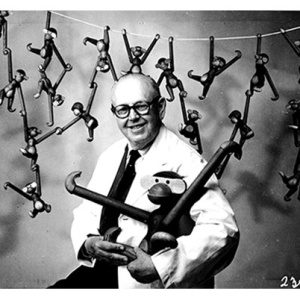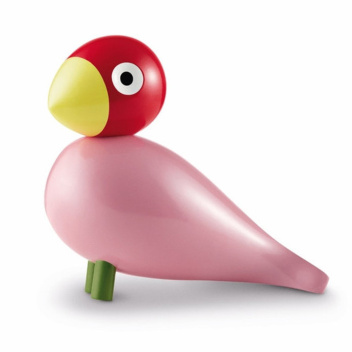Drewniany ptaszek H15,5 cm SONGBIRD - RUTH Rose-Red
Kay Bojesen439,00 zł brutto
KB-6895
After finding pictures of the cheerful beech birds in the old Bojesen family photo album, they were later added to Bojesen's collection of animal figures. The birds have a clean, modern expression, stripped of superfluous details, and yet they are so lifelike that you can easily imagine them singing when the sun comes up.
| Głęb.Szer.W | Height 15.50 cm Width 16 cm Depth 8 cm |
| Motyw | Zwierzęta, Ptaki, Owady, Ryby |
| Materiał | Drewno |
| Kolor | Różowy |
Ten produkt nie występuje już w magazynie.
Produkt na zamówienie ok. 21 dni roboczych
Kay Bojesen Songbird Ruth.
This bird from the songbird family is stylish and cool.
After finding pictures of the cheerful beech birds in the old Bojesen family photo album, they were later added to Bojesen's collection of animal figures. The birds have a clean, modern expression, stripped of superfluous details, and yet they are so lifelike that you can easily imagine them singing when the sun comes up.
This songbird named Ruth represents one of the five original color combinations created by Bojesen. Can you imagine a better start to the day than to be showered with birdsong from a flock of colorful sunshine?
The songbird is 12 cm high and was originally designed in the 1950s in a smaller version. With its beautiful black plumage, the Raven is a classic, stylish member of Kay Bojesen's already beautifully colorful flock of birds. A great gift for a birthday girl or someone you love.
Looks great everywhere due to the unique but simple design, on desk, fireplace, kitchen, cupboard, etc.
Material: lacquered beech wood / Height 20.5 cm - Deep 6.5 cm - Wide 13 cm.
About the designer:
Kay Bojesen graduated as a silversmith in 1910 after completing his studies with silversmith Georg Jensen. He was one of the first Danish craftsmen to embrace functionalism. He was one of the pioneers who organized the Den Permanente association - an artists' cooperative that included a shop and exhibition space that over the decades came to represent the best in Danish and Scandinavian design. 1919 was the beginning of a new era for Kay Bojesen.
He married and his son Otto was born. This sparked Kay Bojesen's imagination and fascination with children, toys and wood and brought back memories of his own childhood when his father (the publisher Ernst Bojesen - the publisher of the Danish satirical annual Blæksprutten (The Octopus)) carved wooden figures for him and him encouraged his children to be creative, imaginative and playful.
Article number: 39400
Colli: 1
The Bojesen family’s terrace in Bellavista was full of flowers, cane furniture... and birds, and at some point a picture of the wooden songbird was found in one of the family’s photo albums, which might well have been inspired by his flying friends on the terrace. It turned out later that there were originally five birds, and since then the family of songbirds has grown big and colourful.
All Kay Bojesen’s sweet songbirds spread joy and capture the hearts of both young and old with their charming personality. The Nightingale was created in collaboration with the new H.C. Andersen House, which opened in the summer of 2021, and is inspired by the world-famous author’s fairy tale about the little bird with the big voice. And the colours of the Nightingale are inspired by the beautiful Chinese Nightingale.
The bird Georg fuses Kay Bojesen’s use of both wood and silver, as both the beak and the legs are decorated with silver leaf. And the gorgeous shades of green in the plumage are inspired by Kay Bojesen’s jewellery with jade stones. The Alfred Bird is named after one of Kay Bojesen’s great-grandchildren. This Nordic name also symbolises the innocence and peace that has always characterised the designer’s wooden figures. The songbird Ruth is named after Kay Bojesen’s Swedish daughter-in-law. She took the family by storm with her femininity and love of pink.
The Sunshine bird represents one of the five original colour combinations. Originally designed in the 1950s, and like its five colourful siblings, it has never been produced before. The Raven songbird is crafted with black feather splendour and is a stylish and classic feature of the otherwise colourful bird collection from Kay Bojesen.
The series also includes the Kay songbird, named after Mr Bojesen himself who was a big fan of the colour blue. He was always wearing either an impeccable blue suit, shirt and tie or white work coat. And the Ernst songbird takes us one place up in the family tree to Kay Bojesen’s father – a gentleman with many talents. He was a businessman, publishing director, cultural personality and also a creative soul who, together with his wife Valborg, inspired his son Kay to create his collection of beloved wooden figures.
The birds series also features Kay Bojesen’s iconic turtle doves in several versions and his sparrows, which he designed in the mid-1930s. These birds bring a touch of romance into the imaginative world of Wooden Figures. Kay Bojesen’s songbirds are a good example of how he, with a simple design, managed to gives his figures life and soul, so that to this day they spark our imagination and speak to the child in all of us, across age and generations.

Kay Bojesen
Kay Bojesen graduated as a silversmith in 1910 after completing his apprenticeship with silversmith Georg Jensen. As one of the first Danish artisans to do so, he embraced functionalism.
Więcej




























